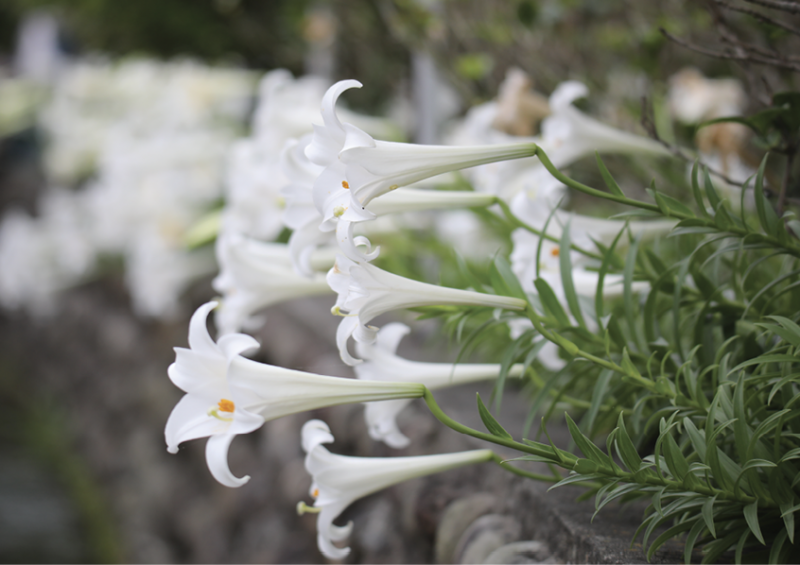
Formosa lilies
I hope to never live through another season like spring 2020. The first few weeks of COVID-19 isolation felt like a perpetual vacation—albeit one tinged with anxiety. But it didn’t take long for deep weariness and uncertainty to set in.
Most of my close friends and family were considered “essential workers,” but as tours manager for the Preservation Society of Charleston, my job was largely on hold. There was nothing for me to do but clean the house, organize closets, or work in the garden. The decision was easy: I retreated outdoors.
Over the course of 25 years, I’ve created a variety of “rooms” in the nearly two acres surrounding my West Ashley home. My husband and I raised our two children here, and it’s evolved accordingly. Today, beds full of colorful perennials and shrubs abound, and the turf is ever-shrinking, becoming more of an area rug than wall-to-wall carpet. There are always a million tasks to complete.
Before getting out of bed each morning in March and April, I mentally surveyed the garden, attempting to make a plan. Sometimes it was easy: I’d continue a project, such as planting my butterfly parterres with a living mosaic of ferns, grasses, hellebores, and ajugas. Other days, I’d end up floundering, doing a little of this and some of that. My restlessness had carried over to the one place where, usually, I felt calm.
I often spent evenings on the porch with my gardening journal, reflecting on a particular plant or design idea. I wrote titles like “Bridge Over Troubled Waters” and “Day 22 of the Quarantine;” they were depressing and descriptive of my mind-set. Looking back, I can see that I was searching for something, but I didn’t know what it was, or how to find it.
Around the first of May, I noticed the fog began to lift. My spirit was lighter and so were the entries in my journal, such as “Yucca Earns Its Name: Bright Edge,” “Spreading Goodness,” “Small Wonders,” and “Fine Tuning and Max Pruning.” Filled with renewed purpose, I wanted to create beauty and celebrate nature once again.
Toward the end of the month, work at the Preservation Society slowly resumed. Though I was eager to plan for the annual Fall Tours (taking place, socially distanced, from October 8 through November 7), I now wanted nothing more than to stay home, toiling in my down (or should I say up?) and dirty world.
I didn’t want to miss one of the highlights of summer—the blooming of the Formosa lilies (Lilium formosanum). A decade ago, Charleston’s “Bulb Lady,” Jan MacDougal, invited me to dig some from her garden. I planted them in one corner of the “pool room,” backed by the tall podocarpus hedge that encloses my family’s swimming spot. It’s prime real estate in my landscape, as I can see it from almost anywhere in the house.
Each year, I let the lilies go to seed, and, over time, they have naturalized throughout the garden. They look like a grass when they sprout in spring, and if you aren’t careful, you’ll weed them right out. But by July, the stems are three to six feet high and loaded with buds. They’re tall and green one day and bursting forth with tremendous white trumpet flowers the next. I think of the poolside gathering as my angels in the choir loft, standing proudly to sing their anthem.
But this year was different. For the first time, the lilies in the “loft” withered and dried before they had a chance to bloom. Yet throughout the rest of the garden, they were more abundant than ever. At least a stem or two brightened nearly every one of my borders and beds—a sight to behold given their statuesque shape and majestic flowers.
In my journal, I wrote “COVID Disbanded the Choir.” Does that sound sad? It isn’t! Popping up here and there, the lilies reminded me of the wedding scene from Love Actually, in which musicians rise one by one to serenade the bride and groom. I realized that my choir had spread out amongst the congregation, just like the real ones affected by COVID-19. The idea brought me peace—the sense of peace, as well as hope, I believe I’d been searching for since the pandemic began.
I once again let the lilies go to seed, and by November, the blooms will have dried into golden, bell-shaped pods. I’ll combine them with boxwood and mums for a Thanksgiving arrangement, then with holly leaves and berries for Christmas. This year, celebrations with friends and family will be particularly special.
I hope the choir will return next summer, stronger and more beautiful than ever. But, having learned to find beauty everywhere—not just in the loft—I’ll also look forward to the sentinels scattered throughout, spreading happiness wherever they happen to land.
Susan McLeod Epstein is a certified nurseryman and horticulturist. As tours manager for the Preservation Society of Charleston, she organizes its largest annual fundraiser, The Fall Tours. Find details on this year’s outdoors-only event, October 8-November 7, at preservationsociety.org.